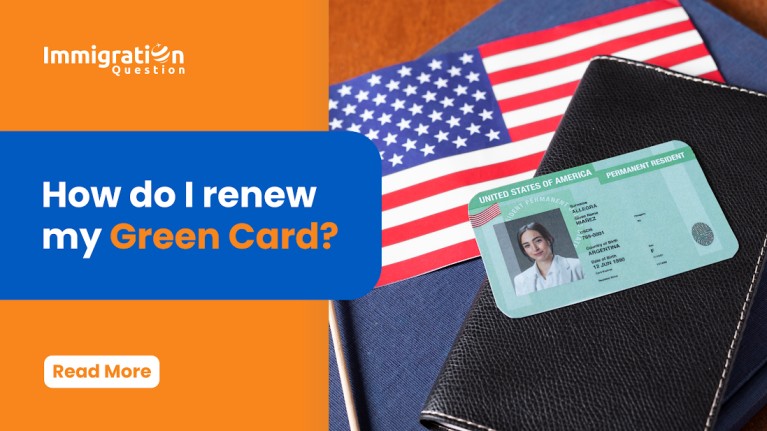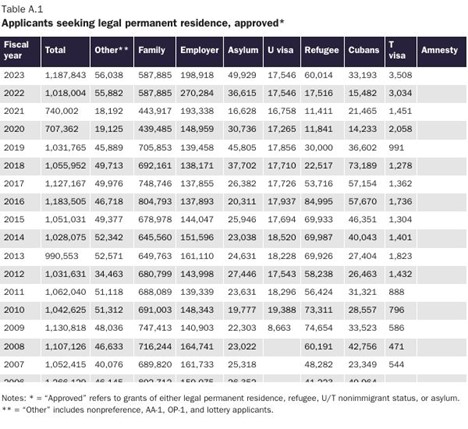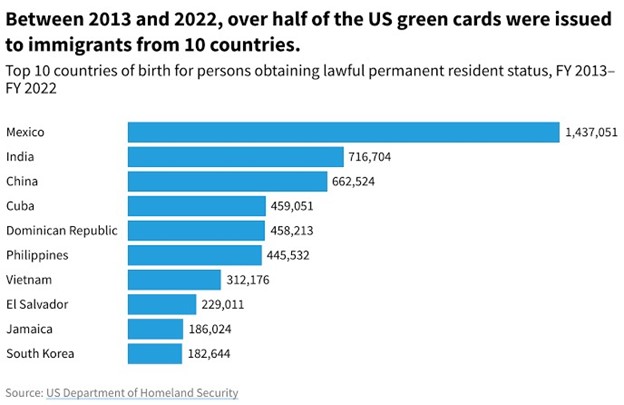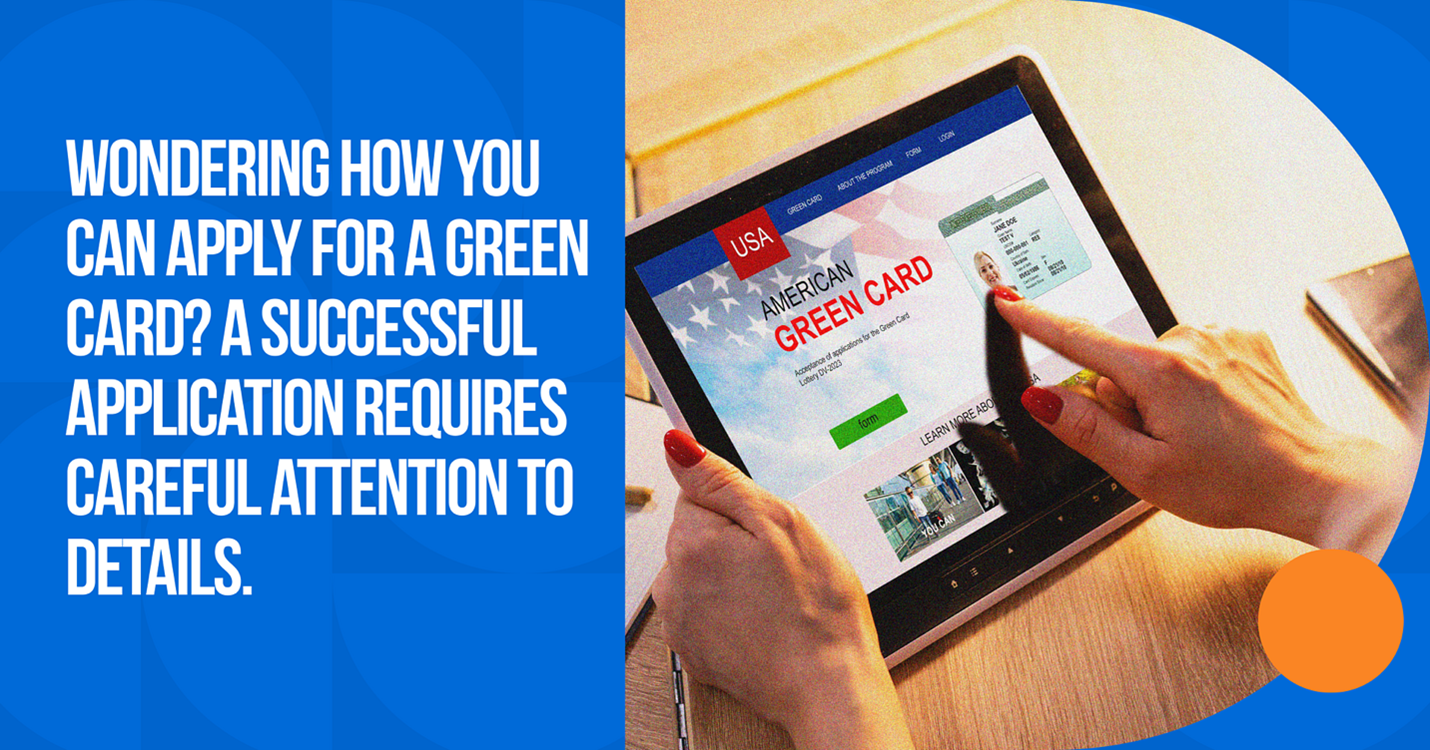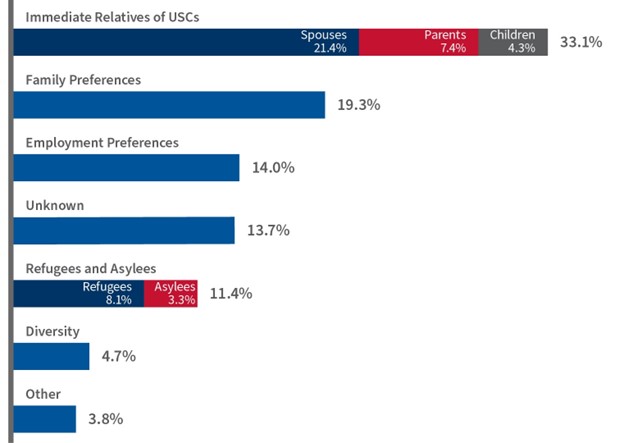What is a Green Card?
A green card, officially known as a Permanent Resident Card, is a document issued by the U.S. government that grants the holder lawful permanent resident (LPR) status. LPR status allows individuals to live and work in the United States indefinitely and provides a pathway to citizenship after a specified period.
Source: CATO.org
The Permanent Resident Card contains the individual’s biographical data, such as their photo, fingerprint, and US green card number. While this card has an expiration date (usually ten years), the person’s permanent resident status remains valid unless it is voluntarily abandoned or revoked by the U.S. government.
For those wondering, ‘How can I apply for a green card?’ It involves specific steps and meeting eligibility requirements. Applying for a green card is a big step toward living and working permanently in the United States. Think of it as your VIP pass to the American Dream! But unlike most VIP passes, this one does not come with a backstage meet-and-greet; instead, it will slap you with a ton of paperwork. Do not worry about that though, as navigating the green card application process does not have to be a headache.
In this blog, we will walk you through each step, ensuring you are prepared to secure that all-important ticket to your future in the U.S. Consult with an immigration lawyer at ImmigrationQuestion.com for legal guidance.
A Brief History of the U.S. Green Card
The name ‘green card’ comes from the 1940s when Form I-151 was printed on green paper. While the color has changed over time, the nickname remained. Today, the card is yellow and includes an alien registration number, US green card number, and a magnetic barcode that stores the holder’s information.
The concept of the “green card” has evolved. Immigration laws and terminology have shifted, reflecting changes in U.S. policy and global migration trends. Since the government began tracking immigration data in 1820, numerous reforms have altered the criteria for U.S. residency.
Recent Statistics on the U.S. Green Card
The demand for green cards has surged recently. In 2022, the U.S. accepted 1.02 million green card applications, a 37.6% increase from the previous year. By January 2023, 12.7 million lawful permanent residents were in the U.S. Nearly 10 million people were issued green cards between 2013 and 2022. For the 2024 fiscal year, around 34.7 million people applied for green cards, a significant rise compared to earlier years.
Source: USAfacts.org / US Department of State
Benefits of a Green Card
Holding a green card grants numerous rights and privileges, making it an invaluable asset for those seeking permanent residency in the United States. Here are some key benefits:
- Pathway to Citizenship: Green card holders can apply for US citizenship after green card status is maintained for five years or three years if married to a U.S. citizen.
- Protection from Deportation: Green card holders cannot be deported because of changes in U.S. immigration laws. Their status remains valid unless they commit a crime or violate U.S. law, which could result in deportation.
- Dual Citizenship: You are not required to renounce your citizenship in your country of origin when you become a green card holder.
- Legal Protections: Green card holders are protected under U.S. law, state laws, and the laws of their local jurisdiction, just like U.S. citizens.
- Family Sponsorship: Green card holders can sponsor immediate family members, such as spouses and unmarried children, to obtain green cards. Although the priority is lower compared to sponsorship by U.S. citizens, it still offers an advantage.
- Green Card Renewal: The card is valid for ten years and can be renewed. Although the card expires, the holder’s permanent residency status remains valid.
- Ease of Travel: Permanent residents can travel abroad and re-enter the United States, provided they return within 12 months. International travel is easier for them than for those with immigrant visas.
- Freedom of Movement: You can live or travel anywhere in the United States without state or local restrictions.
- Access to Federal Benefits: Green card holders can apply for federal financial aid for education and qualify for in-state tuition rates. They may also be eligible for Social Security benefits after residing in the U.S. for a certain period.
- Expanded Job Opportunities: Permanent residents can apply for various jobs, including those requiring security clearances or those with government employers.
- Political Participation: Although green card holders cannot vote, they can engage in political activities like making financial contributions or volunteering for election campaigns.
Understanding Green Card Eligibility
How do I apply for a green card? Understanding the eligibility categories is the cornerstone to acquiring a green card that gives you permanent residency in the United States. Whether it’s reuniting with family members, advancing in your career, seeking refuge, or taking chances with the diversity lottery, each path has its specific requirements. Here’s a quick breakdown of the main eligibility categories and some tips for choosing the best one.
Green Card Application Eligibility Categories: An Overview
1. Family-Based Green Cards
For permanent residency, family-based green cards are one of the most common methods that folks go for. U.S. citizens or lawful residents can sponsor certain relatives, such as their husbands/wives, children, parents, brothers/sisters, etc. The sponsors’ status and relationship between them determine how long the applicant will wait and what process to follow.
2. Employment-Based Green Cards
People, or more accurately, foreigners, who have job offers in the United States receive employment-based green cards. These are usually highly skilled workers, professionals, and people with exceptional abilities in the arts, medicine, and business. Some categories, like EB-5, are meant for investors who create jobs for American workers.
3. Refugee or Asylee Status
Refugees and asylees can apply for a green card, but only after one year of being granted asylum/refugee status in the United States. This category is for people who cannot return to their home country because of persecution or a fear of the same, usually based on race, religion, nationality, political opinion, or membership in a particular social group.
4. Diversity Visa Lottery
The Diversity Immigrant Visa program randomly selects individuals from countries with low immigration rates to the U.S., giving them immigrant visas plus an opportunity for permanent residency. However, those qualified must also meet strict educational/work experience requirements to be considered for this visa.
5. Human Trafficking and Crime Victims
Foreigners who are victims of human trafficking or violent crimes may be eligible for immigration relief under the U.S. immigration law. It is a means to escape exploitation, seek protection, and eventually build a stable life in the U.S.
6. Victims of Abuse
Those who have suffered abuse or mistreatment may qualify for permanent residency under specific protections and laws. The law protects foreign spouses and children who suffer from domestic violence in the U.S. It allows victims of domestic abuse to receive immigration benefits, including the ability to apply for permanent residency status.
7. Registry
Under the registry provision, individuals living continuously in the U.S. since before January 1, 1972, may be eligible for a green card. It allows certain non-citizens who are long-term American residents who are undocumented or present in the country under temporary immigration status to become lawful permanent residents.
Specific Requirements for Each Category
You may think, ‘How can I apply for a green card through these pathways? First, you must know the requirements for each category.
- Family-Based: Here, the applicant must have a qualifying relationship with a U.S. citizen or permanent resident, and the sponsor must meet financial requirements to support them.
- Employment-Based: It requires a valid job offer from a U.S. employer, labor certification (for specific categories), and proof of skills or qualifications.
- Refugee/Asylee: Must demonstrate past persecution or a well-founded fear of future persecution. Requires one year of physical presence in the U.S. after being granted status.
- Diversity Visa Lottery: Applicants must have a high school education or equivalent or two years of work experience in a qualifying occupation.
- Human Trafficking and Crime Victims: Securing the T Visa requires physical presence in the U.S. due to the trafficking, compliance with law enforcement in investigating the traffickers, and fear of retaliation or harm if they were to be removed from the U.S.
- Victims of Abuse: The applicant must prove that there is or was a qualifying relationship with the abuser, that they reside/resided with the abuser, that they are of good moral character, and that they are or have been victims of battery or extreme cruelty.
- Registry: Applicants must prove that they have resided in the U.S. since January 1, 1972.
Choosing the Right Path in your green card application
The process of applying for a green card can be complex and time-consuming. Here are five essential factors to consider before deciding which immigration path to take:
- Eligibility: Each green card category has its unique eligibility requirements. You must understand the qualifications before applying, as incorrect applications can lead to delays or denials.
- Processing Time: Green card processing times vary depending on the category. Gathering required documents and following agency-specific timelines can take months or even years, so patience is essential.
- Country of Origin: Your home country’s immigration processes and fees can also determine how quickly your green card application progresses. Some countries may have slower systems or higher costs compared to others.
- Family Ties: Relationships with U.S. citizens or lawful permanent residents can impact your green card application. Specific categories, like family-sponsored visas, give preference to close relatives such as spouses or unmarried children.
- Legal Support: The immigration process requires precise paperwork and adherence to strict guidelines. To avoid mistakes and increase your chances of approval, consult with an immigration lawyer at ImmigrationQuestion.com.
You’re right if you think all of this must be difficult. Yes, deciding which green card category best works for your situation can be difficult. But here’s what you can do – Begin by assessing your circumstances, such as your relationship with U.S. residents, your professional background, your country of origin, and many others. If you’re not sure whether you qualify for this type of visa, talking to an immigration attorney can help you find answers and advice on how to apply correctly.
Step 1: Determine Your Eligibility
1. Eligibility Check: How to Check if You Qualify for a Green Card
Before looking for answers to the question – how do I apply for a green card? The first thing to understand is whether or not you qualify. Think of it like checking the weather before heading out for a hike—it’s essential! Eligibility depends on family connections, work, or even refugee status. A quick eligibility check can save you a lot of trouble much later. Many government websites have tools that can help you determine your eligibility. But if you prefer a more personalized service, you might want to speak with an immigration attorney.
2. Common Pitfalls: Potential Issues That Could Affect Eligibility and How to Avoid Them
Now, let’s discuss some possible obstacles. In the course of getting a green card, there are many, as occurs with most trips. Common issues that could trip you up include previous immigration violations, incomplete applications, or missing paperwork. But don’t worry! Most of these pitfalls are avoidable with some preparation and attention to detail. So, the big question—what can you do? Check your forms twice, make sure you’ve submitted all supporting documents, and ask for help if you find something that doesn’t make sense. Think of it as packing all the necessary stuff before a big trip—you don’t want to realize you’ve forgotten something important once you’re halfway there!
Source: USAfacts.org / US Department of State
Step 2: File the Right Petition
1. Family-Based Petition (Form I-130): Explanation of the Petition Process for Family-Based Applicants
If your ticket to a green card is a family member who’s already a U.S. citizen or permanent resident, you’ll need to start with Form I-130. The essence of this petition is to show that you genuinely know one another, regardless of whether they’re your brother, sister, child, or better half. When approved, this form permits you to proceed. Remember that this petition calls for careful adherence because it’s a huge step. And If you’re keen on details, it’s your time to shine.
2. Employment-Based Petition (Form I-140): Overview of the Petition Process for Employment-Based Applicants
If employment is your pathway to a green card, then Form I-140 becomes your new buddy. Your American employer submits it to prove they want you in America because of your abilities and talents. It’s like winning the golden ticket by being great at your job. Ensure that your employer is at the top of his game and all the paperwork is in order. You can best believe that you wouldn’t want a tiny oversight to stand between you and a dream career within the borders of the United States.
3. Other Petitions: Brief Mention of Other Petition Types (e.g., Asylum, Refugee, etc.)
Let’s say you’re applying for a green card via another route, like asylum or refugee status. You’ll find that there are different petitions tailored just for you. Each pathway has its own set of rules and paperwork, but the goal is the same – getting you that green card! Knowing which petition applies to your situation is vital so you’re not filing the wrong forms.
Step 3: Submit Your Green Card Application
1. Form I-485: Guide on Completing Form I-485 (Application to Register Permanent Residence or Adjust Status)
Once your petition is approved, it’s time to submit your green card application, known as form I-485. This paper is an official request that you’d like to become a permanent resident of the U.S., so fill it out with care. You can think of it like sending a resume to your dream job. Every detail must be correct and well-presented. Take your time, follow the instructions, and if you get stuck at any point, don’t hesitate to ask for help. It’s always better to clarify early than to correct mistakes later.
2. Supporting Documents: List of Required Documents to Include with Your Application
Your Form I-485 won’t go solo—you’ll need to gather a stack of supporting documents to send along with it. These include your birth certificate, passport photos, evidence for entry into the U.S., and any relevant marriage or divorce papers. Consider these papers the finishing touch or the icing on the cake (if you like); without them, no application is complete! Ensure everything is in order before mailing it out; retain copies for future reference.
3. Application Fees: Overview of the Costs Associated with Applying for a Green Card
Getting a green card isn’t only about filing; charges are also involved. The application fee of form I-485 stands out as one of the significant expenses, but don’t forget others, like the fees for biometrics appointments. It may be wise to factor in these costs so they do not catch you off guard. Consider planning a vacation—knowing the total cost upfront will help you plan well and enjoy the trip even more.
STEP 4: Biometrics Appointment
1. What to Expect: Overview of What Happens During the Biometrics Appointment
After you’ve filed your green card application, you will be called in for a biometrics appointment. The US government will take your fingerprints, photographs, and signature. The process is simple but vital to your green card application. Think of it like updating your profile picture and security settings for your future life in America. And what’s more? It doesn’t take long. You’re done before you know it.
2. Preparation Tips: Advice on How to Prepare for Your Appointment
As you prepare, ensure you have all the necessary documents, such as the appointment notice and a valid ID, with you. Arrive on time (or even early) to avoid hiccups. Now isn’t the time to wing it; a little preparation goes a long way in ensuring everything goes smoothly. Just remember, this is one more step closer to your green card!
Step 5: Attend Your Green Card Interview
1. Interview Process: Explanation of the Green Card Interview and What to Expect
Ah, the green card interview—the crux of your journey! This part of your immigration journey is where you’ll sit with an immigration officer who’ll go over your application and ask any questions they may have. It sounds scary, but they want to know your intentions. Think of it like a job interview, but instead of landing a job, you aim for permanent residency in the U.S.
2. Common Questions: Sample Questions That May Be Asked During the Interview
During the interview, you might be asked about your background, relationship (if applying through family), job (if applying through employment), or any other details in your application. They may even ask surprise questions just to see how good you are at thinking on your feet. You should be fine, though; most queries will be familiar. All you need is composure and sincerity.
3. Preparation Tips: Tips on How to Prepare and What Documents to Bring
With the green card interview, preparation is your best friend. Get yourself ready. Review your application, gather all required documents (including originals), and practice answering possible questions with a partner or family member. In addition, it’s advisable to dress smart and arrive early. You’ve made it this far, so leave no room for mistakes.
Step 6: Receive Your Decision
1. Possible Outcomes: Overview of the Potential Outcomes (Approval, Request for More Information, or Denial)
After going through all that work, this is the moment of truth! Now is where you get the infamous green card decision. The outcomes that could arise from the application process are either approval (yay!), a request for more information (not a deal breaker), or denial (a setback, but not the end of the road). Irrespective of what happens, it is essential to remain cheerful and ready for anything that comes next. Think of it as waiting for exam results; you’ve done your best, and now let’s see how you performed.
2. Next Steps: What to Do Depending on the Outcome of Your Application
If approved, you’ve made it! Hearty cheers! At this point, you’re officially a permanent resident with a US green card number. The following steps involve celebrating and preparing for life as a new U.S. resident. If more information is required, don’t panic; just provide everything needed and keep moving forward. If your application has been rejected, take a deep breath and discuss it with an immigration attorney who can advise you on what to do next. Remember that every story has its ups and downs; this is merely one chapter. Remember also that some great attorneys at ImmigrationQuestion.com can help you with your reapplication.
With these steps in mind, congratulations! You’re well on your way to confidently navigating the green card application process. Good luck, and here’s to your exciting future in the US!
Green Card vs. U.S. Citizenship
While a green card grants lawful permanent residency, it’s much different from U.S. citizenship.
LPRs can apply for US citizenship after green card. Green Card holders married to and living with the same U.S. citizen spouse for three years can apply for U.S. citizenship. In other cases, Permanent residents must wait five years before they can apply for US citizenship after green card.
In fiscal year 2023, USCIS welcomed 878,500 new citizens during naturalization ceremonies held throughout the United States and globally. Most of these new citizens initially entered the U.S. as immediate relatives of U.S. citizens or through family-sponsored preference categories. Other pathways included refugees and asylees, employment-based preference categories, and the Diversity Immigrant Visa Program.
Source: uscis.gov
Some of the differences between green card holders and U.S. citizens include:
- Travel Restrictions: Permanent residents cannot live abroad Extended stays outside the U.S. can result in the loss of residency rights.
- Loss of Residency: Certain crimes and failure to notify U.S. Citizenship and Immigration Services (USCIS) of address changes could lead to deportation.
- Financial Aid Limitations: Green card holders may have to wait five years to qualify for some federal benefits.
- Voting and Political Office: Green card holders cannot vote or run for political office.
- Passports and Taxes: Green card holders do not receive U.S. passports and may face exit taxes if they leave the U.S. after residing for eight years or more.
- No Automatic Extension to Children: Green cards do not automatically extend to children born outside the U.S.
Timelines for Green Card Applications
At this juncture, you may be thinking, ‘How do I apply for a green card and get it fast? The time it takes to process a green card application varies widely. It can take anywhere from several months to years, depending on factors such as:
- The specific green card category.
- The applicant’s location (inside or outside the U.S.).
- Whether waivers of inadmissibility are needed.
- The workload of the USCIS, U.S. consulate, or other service center handling the case.
- The petitioner’s status and the relationship between the petitioner and applicant.
Tips for a Successful Green Card Application
- Know the Requirements: Understand the specific requirements for your green card category, whether through employment, family sponsorship, or other means.
- Legal Assistance: Consider hiring an immigration lawyer if your case is complicated or you’re unsure about any part of the process. Their expertise can make all the difference. Plenty of experienced attorneys are signed up to com.
- Complete Documentation: Ensure all necessary documentation is complete, including forms, proof of employment or family relationships, and financial records.
- Stay Organized: Keep all your documents in order and track deadlines closely – organization is vital to a smooth application process.
- Avoid Common Mistakes: Be mindful of common errors such as submitting incomplete forms, missing deadlines, or failing to pay required fees.
- Effective Communication: Maintain clear communication with USCIS. Respond promptly to any requests for additional information or documentation.
- Follow-Up: If your application is delayed or requires additional information, respond promptly and follow up with USCIS to keep things moving.
Frequently Asked Questions on Green Card Application
1. Who is eligible to apply for a green card?
Eligibility varies but includes family relationships, employment, refugee/asylum status, and special programs like the Diversity Visa Lottery.
2. How can I apply for a green card – which forms do I need to submit?
You’ll need Form I-485 and the appropriate petition form, like I-130 for family or I-140 for employment, plus any additional required forms.
3. How long does it take to get a green card?
The processing time for a green card varies from a few months to a couple of years, depending on the type of green card you’re applying for and where you’re applying from.
4. How long does a visa interview last?
There is no set time, but typically, a U.S. visa interview lasts about 10 to 15 minutes, depending on the case’s complexity.
5. How much does a green card cost?
The filing fee for a family-based green card is $3005 for applicants applying from within the U.S. and $1340 for those outside. Please note that this does not include the cost of the medical exam, as this varies by provider.
6. What should I do if my green card application is denied?
You can appeal, file a motion to reopen, or consult a lawyer to explore your options. Find one at ImmigrationQuestion.com.
Obtaining a green card is a life-changing achievement for immigrants seeking to live and work permanently in the U.S. While the process can be challenging, careful planning, knowledge of the various pathways, and legal assistance can significantly improve your chances of success.
About ImmigrationQuestion.com
ImmigrationQuestion.com is a revolutionary platform that connects immigration attorneys to people who have questions. We provide guidance on U.S. visas, citizenship, and green cards, keep you informed with the latest immigration news, and foster a knowledgeable community for support and insights.

